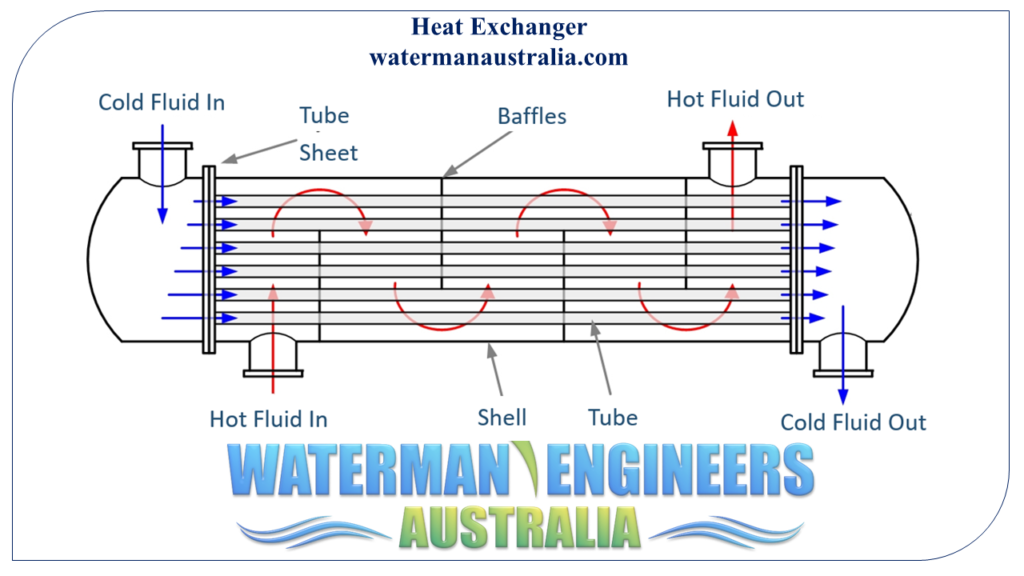
A heat exchanger is a device that allows for the transmission of heat between two different media without any physical contact between them. Heat exchangers work on the idea that thermal energy can be transferred from a hot fluid to a cold fluid. Heat exchangers provide for precise temperature regulation, improving energy efficiency and system functionality by transferring heat between two fluids.
Power plants, chemical plants, HVAC (heating, ventilation, and air conditioning) systems, supermarkets, and many more all employ heat exchangers. They can be found in commonplace home products like air conditioners and water heaters.
In this article, we'll learn about heat exchangers, what they are, how they work, and the different kinds there are. The article also details the common uses and factors to consider when choosing a heat exchanger.
For soiled and viscous fluids, the fouled strain drop in a heat exchanger might be approximately thrice the clear force fall, the two inside of and outside tubes. Trying to keep velocities high adequate to prevent deposits, steering clear of stagnant region/sizzling location/cold spot are mitigation actions in heat exchanger thermal design. In the HTRI program, fouling layer thickness is often entered instantly.
Customers will find out how to work out heat transfer coefficients for convective heat transfer, condensing, and evaporating working with simple equations. Dew and bubble details and features are covered, with all calculations supported with examples.
In the event that both equally fluids are fouling, both straight tubes and detachable bundles are necessary, for this reason the most costly floating-head (AES) style has to be chosen. This type has the most maintainability and use of either side; meanwhile this configuration demands quite possibly the most forging and sealing surfaces, and one of the most machining or grinding surfaces. The consequence of having the very best amount of removable areas is that it's also the most expensive.
There are a selection of pieces that make up a furnace program they usually all function together to produce heat and distribute it to the indoor living Areas.
Gas flames burn off inside these tubes and also the toxic gases are vented with the roof and outside of your house. A blower motor inside of the furnace blows the heated air into your ductwork from your heat exchanger and it is circulated throughout your private home.
is 1. Hence, the exchanger behaviour is independent of the precise configuration. These types of could be the case if one of several fluids underwent a stage modify.
Shell and tube evaporators utilize a series of tubes in just a larger shell to transfer heat. They’re sturdy and responsible, but might be bulky. These are typically more common in commercial refrigeration units.
The pressurized components on the shell and tube exchanger are intended to be in accordance that has a strain vessel layout code like ASME VIII (1993) or BS5500 (1994).
Component failures in heat exchangers can lead to a complete breakdown of your refrigeration technique. Results in can include producing defects, have on and tear, or inappropriate maintenance. Standard inspections and proper servicing will help discover and stop likely failures.
fascinating to readers, or essential within the respective analysis place. The aim is to provide a snapshot of a few of the
The share of heat Restoration is definitely the effectiveness of the unit. Efficiencies usually vary all around eighty%. Usually, these units are very long, shallow and rectangular, with ducts at possibly in the lengthy finishes.
The e-book is extensively illustrated with figures in guidance of the text and involves calculation examples to guarantee consumers are absolutely equipped to pick out, design Designing of heat exchanger manufacturer and style, and function heat exchangers.
Be sure to Take note that this formulation assumes that the heat exchanger is running beneath constant-point out situations and that there is no period transform in any with the fluids concerned.
Air-cooled condensers use air to cool the refrigerant and release heat. They’re frequent in many household refrigerators and are frequently reduced routine maintenance. Even so, they are often significantly less efficient in hotter environments.